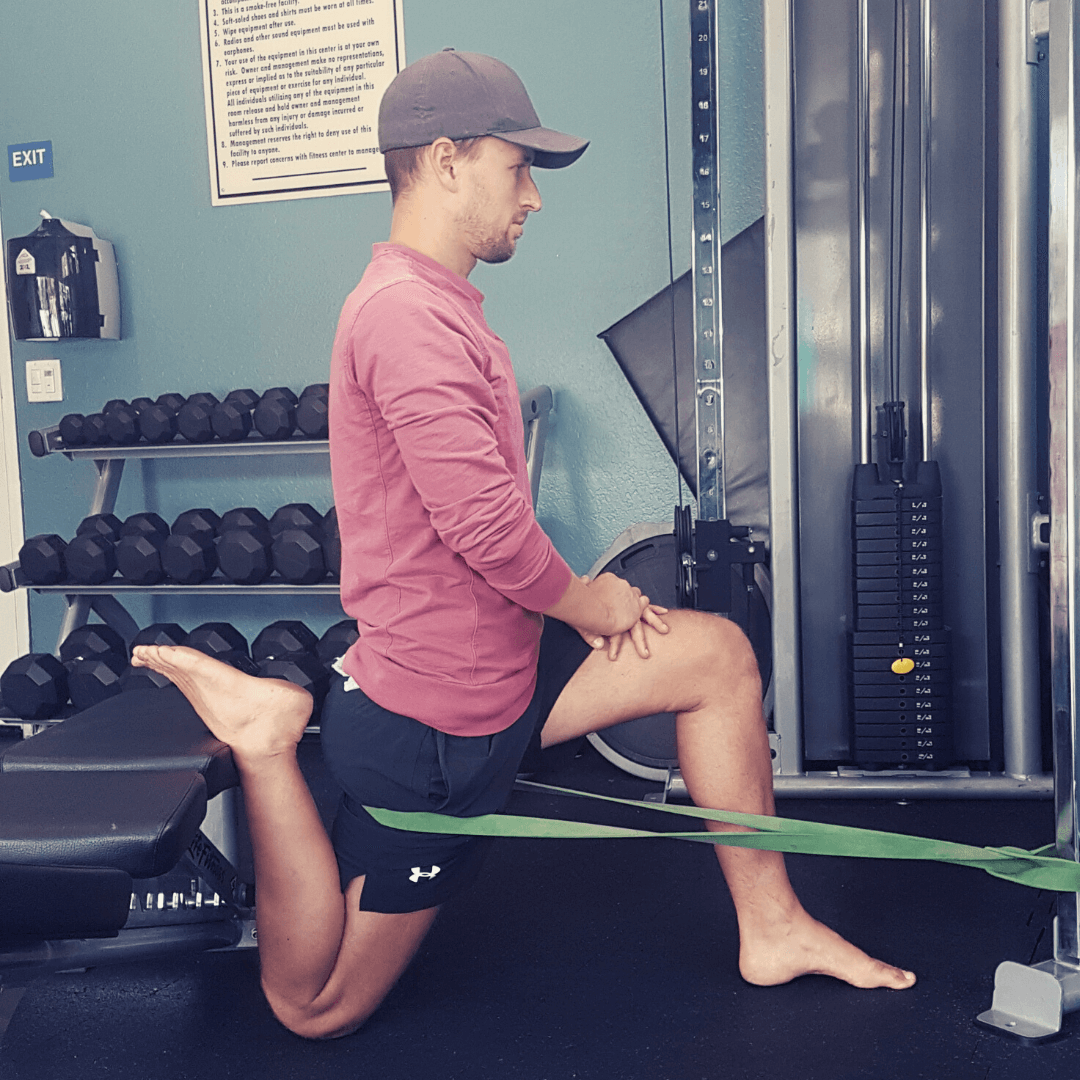
The Couch Stretch: A Physio's Guide to Fixing Hips, Back & Knee Pain
As a Physiotherapist, I'm constantly searching for the root cause of my patients' pain. Interestingly, it's rarely where the pain actually is.
When asked for the "best" stretch, one exercise consistently stands out for its profound, whole-body impact: the Couch Stretch.
This isn't just another hip flexor stretch. It's a powerful tool to combat the modern epidemic of sitting, a position that tightens hip flexors, stiffens joints, and creates a cascade of dysfunction from your lower back to your ankles.
From its simplicity and scalability to its capacity for immediate change, the Couch Stretch is a non-negotiable exercise for anyone seeking to prevent injury, recover from pain, or optimise their physical performance. So, let's dive into why this is arguably one of the most useful stretches you'll ever do.
Table of Contents
Origins of the Couch Stretch and a Physio's "Aha!" Moment
The Couch Stretch was popularised by the brilliant Dr. Kelly Starrett of The Ready State (formerly MobilityWOD). It came into my professional life at a time when I was questioning traditional Physiotherapy approaches that often treated the site of pain without addressing the underlying cause.
Discovering the Couch Stretch was a confirmation. It gave me a practical, potent tool to address a fundamental issue: hidden hip restrictions that create consequences elsewhere. The video below is the one that first opened my eyes to its power almost a decade ago.
How to Do the Couch Stretch: A Step-by-Step Guide
Before we explore the deep benefits, let's master the form. All you need is a chair, couch, or bench. If you have sensitive knees, place a cushion or pillow underneath for support.
Time needed: 2 minutes per side
How to do the Couch Stretch (Beginner - Using a Chair)
- Positioning: Kneel on the floor and place your back knee into the back corner of a chair, with your shin vertical against the backrest. Your front foot should be flat on the ground at a comfortable distance in front of you, creating a 90-degree angle at your knee.
- Phase 1 - The Hip Flexor: Keeping your back straight, gently lean forward. Squeeze the glute (buttock muscle) of your back leg and press your hip downward. You should feel a deep stretch in the front of your hip. Hold for 2 minutes.
- Phase 2 - The Quadriceps: Maintaining a straight back, slowly bring your torso more upright, bringing your bottom back toward your back foot. Focus on extending through the hip, not arching your lower back. You'll feel this more intensely down the front of your thigh. Hold for 2 minutes.
- Muscle Tensing (PNF): To deepen the stretch, intermittently tense the muscle you feel stretching for 5-10 seconds, then relax and gently push a little deeper. This "contract-relax" technique (Proprioceptive Neuromuscular Facilitation) helps create immediate changes in tissue flexibility.
- Breathe: This stretch can be intense. Breathe comfortably, slowly, and deeply throughout to help your nervous system relax and allow for a deeper release.
Watch the video below for a real-time demonstration of the technique.
Related: What is the best way to stretch? Find out here!
Scaling Up: Advanced Couch Stretch Variations
The beauty of this stretch is its scalability. Once the beginner version feels comfortable, you can progress:
- Floor & Wall Version: Perform the stretch on the floor with your back foot pressed against a wall. This increases the demand on both hips.
- Add a Power Band: For a deep joint capsule stretch, add a power band as shown in the video below. This is crucial for targeting the deepest layers of hip restriction.
- Elevated Front Foot: Place your front foot on a step or stool to further increase the stretch's intensity.
9 Proven Benefits: More Than Just a Hip Stretch
While it's a fantastic hip flexor stretch, its true value lies in solving problems throughout the kinetic chain. Here’s why it’s a cornerstone of root-cause Physiotherapy.
1. Combats the Root Cause of Sitting-Related Tightness
Sitting is the primary cause of modern hip stiffness. It shortens the hip flexors and adaptively tightens the anterior hip joint capsule. The Couch Stretch is a direct antidote to this prolonged position, restoring function.
2. Relieves Lower Back Pain
Your hip flexors, like the psoas, attach to your lumbar spine. When they are tight, they can contribute to spinal dysfunction, altering pelvic positioning and increasing load on the lower back. By releasing these muscles, you may genuinely have the potential to decrease lower back pain.
3. Reduces Knee Pain
Tight hips force the body to find movement elsewhere, often leading to excessive rotation or stress at the knee. This can be a key factor in patellofemoral pain, IT band syndrome, and the development of arthritis long-term. Similarly, tight hips and thigh muscles can change the resting tensions through the knee, opening the door for patellar tendinopathies.The Couch Stretch addresses the root cause by restoring hip extension, and loosening tissue through the anterior chain - improving the function of the knee from above. For a deeper dive, see my article on the root cause of knee pain.
4. Improves Pelvic Positioning and Core Function
A tight rectus femoris (one of the quadriceps) can pull the pelvis into an anterior tilt. The Couch Stretch helps re-establish a neutral pelvic position, which is the foundation for optimal core and pelvic floor function.
5. Enhances Athletic Performance
From running and cycling to squatting and jumping, nearly every athletic movement requires full hip extension and normal hip and thigh function. Releasing hidden hip and thigh restrictions with the Couch Stretch allows for more optimal movmement. Say hello to a more powerful stride, deeper squats, and improved overall performance.
6. Stretches Multiple Muscle Groups Simultaneously
This one stretch effectively targets the psoas, rectus femoris, quadriceps, TFL, and even the anterior ankle. It's a highly efficient way to address lower-body tightness without spending 20 minutes on multiple isolated stretches.
Common Mistakes and How to Fix Them
-
Mistake: Arching the lower back to go further.
Fix: Focus on squeezing your glute to drive the hip forward, not on leaning back with your spine and focus on extending through the hips not the lower back -
Mistake: Letting the hip shunt out to the side.
Fix: Keep your back knee and hip in a straight line. Your shin should remain relatively vertical. - Mistake: Holding your breath.
- Fix: Use deep, diaphragmatic breathing to signal safety to your nervous system, allowing for a deeper release.
Conclusion: Your Foundation for a Pain-Free Body
The Couch Stretch is more than an exercise; it's a fundamental correction for a modern lifestyle. By investing a few minutes a day, you're not just stretching a muscle - you're addressing the root cause of common pain in the back, knees, and hips. It can be challenging at first, but its unparalleled ability to create change makes it one of the most valuable tools in your wellness arsenal.
Frequently Asked Questions
Aim for a total of 2-4 minutes per side, broken into the two phases described. Make sure you pair it up with the PNF stretching model to achieve immediate results. Consistency is more important than duration.
You should primarily feel it in the front of your hip (hip flexors) and down the front of your thigh (quadriceps). You should not feel sharp pain in your knee or lower back.
It can, if your sciatica is driven by pelvic dysfunction or tight hip flexors that alter spinal mechanics. By improving pelvic positioning, this may improve how you load the sciatic nerve.
Respect it. This often indicates a technique issue or an underlying knee problem. Use more padding under your knee, ensure your shin is vertical, and consult a Physiotherapist for a personalised assessment.
It's more specific and intense. While lunges are a great dynamic movement, the Couch Stretch provides a sustained, targeted stretch that is superior for releasing deep capsular and muscular tightness.
Need Personalised Guidance?
If you'd like help trying to uncover the underlying cause of your pain or dysfunction, consider booking an online Telehealth consultation with Grant here!

